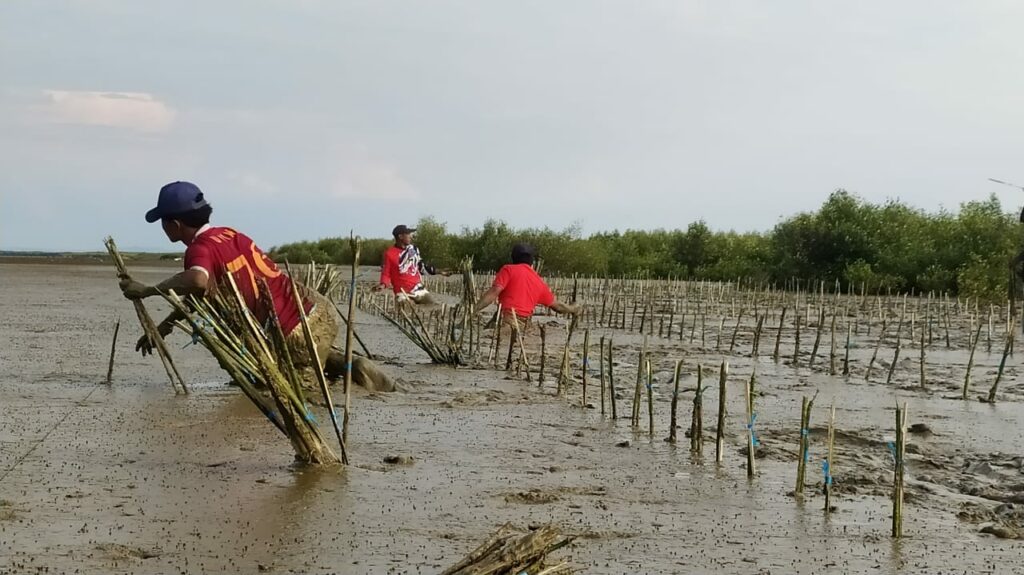“I told the people that planting mangrove is a form of good deeds. If we plant it, it will produce oxygen, protect marine biota and prevent abrasion.”
Feeling concerned about the condition of coastal area in his village, Adi Sucipto initiated mangrove planting along the coast of Kertomulyo in Trangkil district, Pati regency, in 2014.
The inspiration to plant the mangrove came when he was fishing with some other young men of the village. They saw that the beach was hot and arid. When the high tide came, the beach was often hit by abrasion.
Since then, Adi and nine other young people agreed to turn the arid beach into a green area. They established an organization that took care of the northern coast of Pati called “Peduli Pantai Utara Pati” or PPUP. Adi was appointed as the leader.
He was grateful that the village’s young people gave a good response to his idea to protect the environment there, even though he only conveyed his idea in modestly. “I told the people that planting mangrove is a form of good deeds. If we plant it, it will produce oxygen, protect marine biota and prevent abrasion,” said the 46-year-old man.
As the first move, they planted 1,000 mangrove seeds. The seeds were bought from the membership fee of PPUP. During a year, they planted and took care of the mangrove independently. “We collected money to buy seeds,” Adi explained.
Even though Adi and his friends struggled by spending money from their own pocket, there were some villagers who looked down on what they were doing. The villagers considered the activities of “struggling in the mud without earning money” as something unreasonable. “They thought that we were doing something useless after we graduated from school. They said we were planted for nothing. They even called us crazy,” Adi recalled.

The fund to plant the mangrove was also obtained by raising donations from T-shirts sale. Purchasing one T-shirt means that the buyer donates five mangrove seedlings. Surprisingly, they managed to sell about 500 T-shirts.
A year later, the results of their work attracted the attention of the Organization for Industry, Spiritual, Culture, and Advancement or OISCA. According to Adi, in the first year, the mangrove they planted grew well in the area of 10,000 squaremeter.
Previously, OISCA has been working with the Kertomulyo village administration since 2009 to protect the coastal environment. OISCA then switched their works by focusing more on mangrove conservation with PPUP.
Over time, the mangroves they planted continued to thrive. In 2016, they made a simple hut as a resting place and built a bridge to cross the estuary that separates the mangrove planting area. Unexpectedly, people often flock to the gazebo and make it their favorite place. Kertomulyo Beach was then known as a new tourist destination in Bumi Mina Tani.
Currently, according to Adi, around 200 tourists visit Kertomulyo Beach every day. What was once hot and muddy place has become a new destination for people to unwind. It also created employment for local residents. Adi noted that there were five villagers who sell their commodities every day in that place. At certain times, there were more traders coming, at least 12. “All traders are the residents of Kertomulyo village,” he said.
Two years ago, PPUP started to form a cooperative. Traders who sell their things on Kertomulyo Beach are required to shop at the cooperative. The profits are used for the benefit of PPUP members, who have struggled for years to preserve the environment of Kertomulyo. At present, PPUP has 38 members.
This condition has not only improved the local economy, but also the environment. The abrasion that used to hit the beach, whenever there was a high tide, never happen again after about 25 hectares of the shoreline are planted with mangroves. “Abrasion used to occur every May-June when the sea was high. It damaged the ponds. But now, it is safe and protected,” said Adi.
Various types of biota that previously did not exist are now living among the mangrove trees. One of them is crab and eel. “In the past, there were no crabs. Now, local people can become a crab hunters and make it as their livelihood,” he said.
PPUP Secretary, Moh Asyhar Fikry, said that although the tourism potential on Kertomulyo Beach is quite high, the utilization of the area for tourism is limited to a maximum of 20 percent of the existing land. The tourism also applies a concept of “learning about mangroves”. Tourists can get information about the types of mangrove plants and examples in an information center.
The local government has also gained the green impact of the Kertomulyo coast. “Since 2018, the conservation program began to receive a response from the government,” he said. This year, Kertomulyo Beach won the first place in the regional planning competition at the Central Java Province level and entered the top 10 at the national level.








PUBLISHED BY CLIMATE HEROES